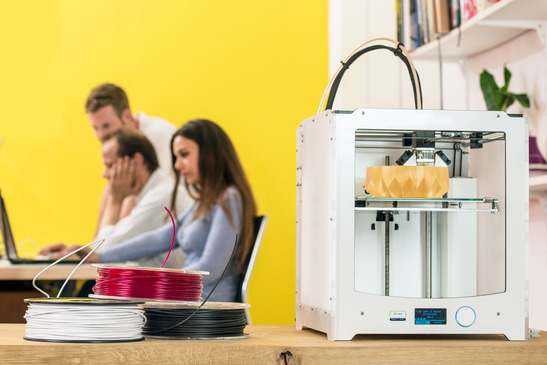
You may ask, why is a video production company featuring 3D printing on its blog…. Well the two may be more closely intertwined than you think. With the rise of augmented reality as a means of delivering high-quality, targeted video production to consumers, physical objects are being used as triggers for those augmented reality experiences.
For example, if you imagine yourself in a car showroom, instead of picking up a brochure, in the near future you may be given an iPad. That iPad will feature an app which triggers an AR experience when pointed at a physical object. Imagine if the sales person were to give you a small 3D printed version of the car you like for you to take home. You fire up your iPad or smartphone, download the app and hey-presto you can take a 3D tour of the car on your kitchen worktop, all triggered by the placement of the 3D printed car.
Videos would play, explaining the details of the car and how it will benefit your life. This is all working technology right now so our Production Co-ordinator Dylan Rees thought it was time to take a closer look into the world of 3D printing.
The rise of 3D printing presents a lot of exciting opportunities for brands. The sheer expanse of different applications it has is almost limitless, even with the technology only recently becoming prevalent on the mass market. So how does this technology actually work, and how can your brand utilize 3D printing as part of its marketing strategy?
3D printing depends on a comprehensive digital design. This can be done by creating a design from scratch on specialist 3D printing software, or by using a 3D scan of an item that you wish to reproduce, or even by digital camera and photogrammetry software.
Once this digital 3D model is produced, the model must then undergo a process called slicing. Slicing is where the model is divided into thousands of horizontal layers. Once sliced, the data can be fed back to the 3D printer.
With the image uploaded the to the printer, the printer begins printing each 2D layer on top of each other to create a 3D model.
What can be 3D printed?
The answer to that question is almost anything. At Paris Fashion Week, Iris van Herpen showcased a range of 3D printed apparel, while a company called Solid Objects recently printed a fully working gun and Local Motors printed a fully working car. If all that wasn’t enough, you can also print in wood, salt, ceramic, gold, proteins, biscuit and chocolate.
How will 3D printing impact business?
The effects on business could be widespread and in many ways change the way we conduct business in the future.
The ease with which items can now be 3D scanned and 3D printed means commercial laws and IP rights will need to be adjusted accordingly. For instance, if you 3D scan and print an Estwing Hammer, this print is technically a bootleg and in breach of IP laws.
Supply chain management will also be affected. Traditionally a product will be manufactured, sent to retailers and then purchased by consumers. But if a customer has access to a 3D printer and a CAD (computer aided design) file for a product, then they can simply print the item at home. We could very well see future market places dominated by the sale and indeed piracy of CAD files.

With items being printed by the consumer or printed to order, the need for large storage spaces will be reduced. Just as the need for expensive store fronts was reduced by online retailers, so the same will be true for warehouse. Driving down business overheads and inventory taxes.
Bespoke items will become the norm, reducing the large scale standardization that currently dominates the market place. Why stock size eight shoes, when a customers can get shoes measured and made to their exact foot size.
How will 3D printing be used by marketers?
While there are countless possibilities of how 3D printing can be used by marketers, Ivan Hope of 3D body scanning company Shapie Me, feels it is the larger implications of 3D printing that will affect the industry “When considering what use 3D printing can be for marketing it is important to see the technology as part of a mix rather than as a solution in its own right. I am fascinated by the potential that 3D printing has for creative projects and look forward to seeing what marketers come up with.”
But as 3D printing offers a quick and customizable product, some of the more practical uses include product samples, scale models of events, unique souvenirs, add ons for existing promotions and bespoke items for client presentations concerning potential campaigns.
So what’s next?
With brands like Coca-Cola, Nokia, Volkswagen, and eBay currently experimenting with 3D printing, it seems that big brands are taking the prospects of 3D printing very seriously. We’ve already discussed the possibility of bespoke clothing, but Twitter cofounder Biz Stone recently predicted that Nike could become a software company in the next decade, thanks to 3D printing. There is also the issue with IP laws that need to be ironed out and current business models will need to be adapted. But the impact on virtually every industry is assured, so marketers should be prepared to embrace this new technology, while dealing with the challenges it presents, as it disrupts traditional business models.
